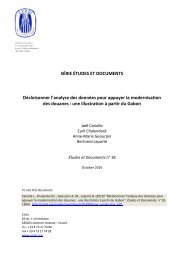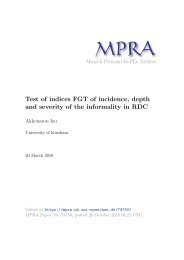You also want an ePaper? Increase the reach of your titles
YUMPU automatically turns print PDFs into web optimized ePapers that Google loves.
EVIDENCE FOR ACCOUNTING RATHER THAN REAL RESPONSES<br />
4.2 PRESENCE OF TAX AVOIDANCE<br />
Tax avoidance and evasion is a widespread pracse in <strong>Hungary</strong> (see Balog (2014), and Benedek et al. (2013) for a summary on<br />
tax evasion studies). In this subchapter I present esmaon results indicang the presence of tax avoidance among Hungarian<br />
firms. In the seminal model of tax evasion economic agents base their decision on comparing the expected costs and benefits<br />
of tax evasion; hence the higher the audit probability and the amount of fine, the higher is the deterrence effect (see a survey<br />
by Slemrod and Yitzhaki (2002)). In an empirical study Kleven et al. (2011) find that prior audits have a strong posive impact<br />
on self-reported individual income in the following year, suggesng taxpayers update their beliefs about detecon probability<br />
based on experiencing an audit. In line with their reasoning, I look at whether audited firms also increase their reported profit<br />
rate aer tax inspecons. If tax evasion is prevailing among firms, then aer an audit they are likely to update their detecon<br />
probability beliefs, and due to the deterrence, increase their reported profit rate (either via reducing cost over-reporng or<br />
revenue under-reporng).<br />
There is no available micro data informaon on tax audit inspecons conducted by the Hungarian tax authories. However,<br />
there is a regulaon requiring firms to increase their tax base with obligaons and fines due to legal consequences set out by<br />
law penales, that provides an indirect indicaon on previous tax audits finding any infringements. Beside tax penales, the<br />
variable also includes fines established in binding decisions such as issued speeding fines when driving a company car.¹³ The<br />
tax form does not contain the types of penales; hence the variable is only a proxy for firms that were inspected and found to<br />
be not complying with the tax law.<br />
According to the previous reasoning, if a tax evading firm experiences an audit, then it updates its detecon probability belief,<br />
then based on this it is likely to increase the reported profit rate. Using the available firm level data on tax penales, I look at<br />
whether firms that were audited and were issued with a fine increased their reported profit rate more than other firms. Table<br />
14 in the appendix reports the regression results, where the dependent variable is the percentage point change in the reported<br />
profit rate, audit is a dummy variable for firms that were audited and fined before the tax year, and the coefficient of interest<br />
is the esmated coefficient for this laer variable. The coefficient of interest is posive and significant in each year, suggesng<br />
that firms that were audited and fined increased their reported profit rate on average more, hence it is a prima facie <strong>evidence</strong><br />
on the deterrence effect of tax audit and the prevalence of tax evasion. Aer providing <strong>evidence</strong> on the widespread of tax<br />
evasion, I will look into how the introducon of the reform affected it.<br />
4.3 REDUCTION IN COST OVER-REPORTING<br />
To be able to analyze the anatomy of behavioral responses, it is essenal to detect how firms changed their reported cost structure<br />
when they switched <strong>from</strong> the revenue to the profit regime due to the reform. Hence, I esmate how an average firm behaved<br />
aer the reform compared to how it would have behaved without the reform, this way esmang the addional changes<br />
due to the reform. I find large reducon changes only in material cost reporng, which is the most easily over-reportable item,<br />
providing further <strong>evidence</strong> for the hypothesis that responses are driven by accounng reporng rather than real producon.<br />
As firms switch regimes also independently of the reform, I compare the year to year changes in reported cost items aer the<br />
reform to reported changes before the reform. As can be seen earlier in Figure 3, the excess amount of <strong>bunching</strong> is located<br />
between the profit threshold of 2 per cent and profit rao of 6 per cent; this is why I focus on firms that reported a profit rao<br />
between 0 and 2, and then switched to a profit rao between 2 and 6 per cent in the next year.¹⁴ In this difference in difference<br />
(DID) esmaon setup, the control group contains firms that crossed the regime threshold <strong>from</strong> 2005 to 2006 immediately<br />
before the reform, while the treatment group contains those that crossed <strong>from</strong> 2006 to 2007, the year immediately aer the<br />
reform.¹⁵ The control group shows the normal year to year changes in cost structure before the reform as firms switch <strong>from</strong> a<br />
profit rate of 0-2 to 2-6 percent. The before-aer comparison for the treatment group includes this operaonal change, and<br />
also addional changes due to the reform.<br />
Figure 5 presents average changes in reported cost raos, i.e. the cost item share in net revenue. The grey bars represent<br />
the average changes before the reform, the blue bars the changes aer. For example the first two bars show that on average<br />
¹³ It does not include failure to perform the contract penales.<br />
¹⁴ As a robustness check I re-esmate the regressions with firms switching to a profit rate between 2 and 8 percent and get similar results.<br />
¹⁵ Two firms with more than one billion HUF loss were excluded <strong>from</strong> the sample.<br />
MNB WORKING PAPERS 3 • 2016 19





